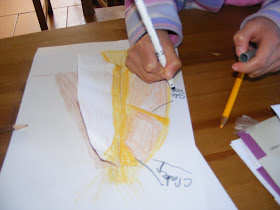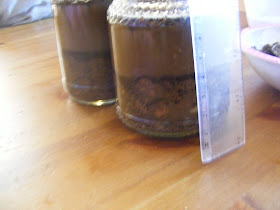We started our Rock Study with a 'dig and discover game' to grab their interest (plaster filled with small gemstones that they have to dig out, combined with a gemstone poster to help identify them)
Next we used salt dough to create a model of the earth which we cut in half to examine the layers along with some 3 part cards and discussed how the rocks around us originally came from the molten rock within the earth that had cooled.
I love that they decided to make a volcano showing the lava coming out and cooling into rocks.
We moved onto reviewing the parts of a volcano and creating a lift the flap drawing of one.
Now that they had a better understanding of where rocks came from we moved to the 3 main types and used these experiments/activities to cement their understanding.
Igneous Rock - we created a volcano out of foil around a tin and used icing sugar mixed with water to create lava (both thick and runny) poured it down the sides and then left it to set while we watched brainpop, wrote up about igneous rock and looked at photos of pahoehoe lava (like our thick icing).
Once set we looked at how it had hardened (like lava turning into rock) and how in some places the top had set but the underneath was still runny.
Sedimentary Rock - We started with a discussion about erosion - their initial ideas on how rock broke down were quiet amusing (someone stepped on it, used a hammer to break it, it rolled down the mountain and smashed etc) - so we came up with some activities to show how rock breaks.
Freezing and thawing - Discussed how water expands when it frozen then they gathered a selection of rocks and placed them in water and popped it in the freezer. Once frozen they took it out to thaw - this step was repeated 3/4 times and the final result was compared with a photo of the rocks prior to freezing.
Water absorption - I asked then how water would get into a rock - the first response was spot on 'does it have small holes/pores like our skin?' proof that they do occasionally listen : )
To prove this they weighed a piece of chalk then popped it in some water for 15 mins and reweighed (when the chalk goes into the water you can see all the air bubbles coming off) Next they popped some pumice into water, left overnight and reweighed in the morning.
For those who want to incorporate some math into this unit you can work out how much water is absorbed as 1g = 1ml of water (or so I'm told, please feel free to test this with a graduated cylinder, scales and pumice and let me know)
They also decided it would be fun to put the waterlogged chalk into the freezer to see it crack. Who am I to argue : )
Once they understood erosion we discussed how sedimentary rocks forn and used a hands on activity to show an example of this. Spoon some soil, sand, gravel and small stones into a jar. Cover with water and pop the lid on - give it a good shake then leave to settle. They measured the depth of each band and re shook, this kept them amused for ages (we still have the jars on the side)
Then looked at the layers in some sedimentary rocks
We also discussed how most fossils are found in sedimentary rock and why they thought this was. Followed by making their own fossils - make an imprint in damp sand and pour plaster over, leave to set and look at your result.
Metamorphic rock - We first reviewed the two types of rock we had discussed then I asked if they could guess what the name of the third kind meant - metamorphic; when they couldn't I asked if they knew of any other words that sounded similar (metamorphosis) and what it means. Eventually they realised that metamorph was change so metamorphic rock was rock that had been changed. Examined some metamorphic rocks and discussed how heat and pressure change rock (a great example is coal changing to diamond) and used the following activities to reinforce the concept.
Take 2 slices of white bread and two slices of brown bread, place them on top of each other and observe (soft, layered, pliable, depth etc) next place the bread under some heavy books, once squished place it in the microwave or oven to harden and observe and compare with your original observations.(hard, flat etc)
Place some candy balls in the bottom of a jar, In a slightly smaller jar place some weights - observe. Pop in a low oven for a while (beware - burnt candy STINKS) remove and allow to cool - observe and compare.(goes from soft to hard and glassy)
We discussed Moh's scale of harness and used our rock detective pages to identify and learn about different rocks/minerals.(with the help of some guides)
We finished by completing a Rock and Mineral workbook from School Express, reading various books and watched different documentaries about the earths structure, volcano's and rocks.



















This is soooo cool! I may have to borrow some of these ideas in the fall when we study rocks!
ReplyDeleteRenita
www.krazykuehnerdays.com
WOW you guys did a lot. We studied volcano last year wish I had thought of the sugar icing as lava as that was a great experiment. I love all the experiments you did I will have to borrow a few of them very soon:)
ReplyDeleteWow! your volcano was awesome! We workd on this stuff in the fall, but it wasnt as good as yours! I will have to remeber this for when we hit rock again!
ReplyDeleteOh, were you going participate in our Nature tray swap? I never got a for sure! :) Let me know!
http://discoverydaysandmontessorimoments.blogspot.com/2011/04/nature-tray-swap-ready-to-go.html
Great activities! I just find your blog via Montessori Print Shop Facebook Page, and I love it :-)
ReplyDeleteThanks for sharing great activities!
Happy Easter :-)
ReplyDeleteI am stopping by from the Tailspin Hop and I am your newest follower!
ReplyDeleteYou can find me here~
http://debshere.blogspot.com/
Have A Great Day!
Deb
What an awesome unit. I love the volcano.
ReplyDeleteWOW! These are great lessons! Your volcano looks like it was alot of fun! Thanks for sharing on NOBH :)
ReplyDeleteGreat readinng your blog
ReplyDelete